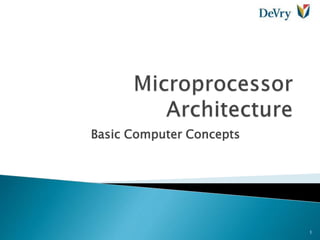Ecet330 1 b - basic computer concepts
•Download as PPTX, PDF•
1 like•542 views
Overview of CPU Architectures
Report
Share
Report
Share

Recommended
Recommended
More Related Content
What's hot
What's hot (20)
Addressing modes/Addressing Mode with illustration/ Addressing mode in 8086

Addressing modes/Addressing Mode with illustration/ Addressing mode in 8086
Class 7 an 8 bit embedded platform -instruction set

Class 7 an 8 bit embedded platform -instruction set
Flag registers (assembly language) with types and examples

Flag registers (assembly language) with types and examples
Assembly language (Example with mapping from C++ to Assembly)

Assembly language (Example with mapping from C++ to Assembly)
Central processing unit and stack organization r013

Central processing unit and stack organization r013
Similar to Ecet330 1 b - basic computer concepts
Similar to Ecet330 1 b - basic computer concepts (20)
More from Ralph Ambuehl
More from Ralph Ambuehl (7)
Recently uploaded
https://app.box.com/s/7hlvjxjalkrik7fb082xx3jk7xd7liz3TỔNG ÔN TẬP THI VÀO LỚP 10 MÔN TIẾNG ANH NĂM HỌC 2023 - 2024 CÓ ĐÁP ÁN (NGỮ Â...

TỔNG ÔN TẬP THI VÀO LỚP 10 MÔN TIẾNG ANH NĂM HỌC 2023 - 2024 CÓ ĐÁP ÁN (NGỮ Â...Nguyen Thanh Tu Collection
https://app.box.com/s/x7vf0j7xaxl2hlczxm3ny497y4yto33i80 ĐỀ THI THỬ TUYỂN SINH TIẾNG ANH VÀO 10 SỞ GD – ĐT THÀNH PHỐ HỒ CHÍ MINH NĂ...

80 ĐỀ THI THỬ TUYỂN SINH TIẾNG ANH VÀO 10 SỞ GD – ĐT THÀNH PHỐ HỒ CHÍ MINH NĂ...Nguyen Thanh Tu Collection
Recently uploaded (20)
Unit-V; Pricing (Pharma Marketing Management).pptx

Unit-V; Pricing (Pharma Marketing Management).pptx
TỔNG ÔN TẬP THI VÀO LỚP 10 MÔN TIẾNG ANH NĂM HỌC 2023 - 2024 CÓ ĐÁP ÁN (NGỮ Â...

TỔNG ÔN TẬP THI VÀO LỚP 10 MÔN TIẾNG ANH NĂM HỌC 2023 - 2024 CÓ ĐÁP ÁN (NGỮ Â...
Sensory_Experience_and_Emotional_Resonance_in_Gabriel_Okaras_The_Piano_and_Th...

Sensory_Experience_and_Emotional_Resonance_in_Gabriel_Okaras_The_Piano_and_Th...
HMCS Vancouver Pre-Deployment Brief - May 2024 (Web Version).pptx

HMCS Vancouver Pre-Deployment Brief - May 2024 (Web Version).pptx
General Principles of Intellectual Property: Concepts of Intellectual Proper...

General Principles of Intellectual Property: Concepts of Intellectual Proper...
Beyond_Borders_Understanding_Anime_and_Manga_Fandom_A_Comprehensive_Audience_...

Beyond_Borders_Understanding_Anime_and_Manga_Fandom_A_Comprehensive_Audience_...
Basic Civil Engineering first year Notes- Chapter 4 Building.pptx

Basic Civil Engineering first year Notes- Chapter 4 Building.pptx
This PowerPoint helps students to consider the concept of infinity.

This PowerPoint helps students to consider the concept of infinity.
80 ĐỀ THI THỬ TUYỂN SINH TIẾNG ANH VÀO 10 SỞ GD – ĐT THÀNH PHỐ HỒ CHÍ MINH NĂ...

80 ĐỀ THI THỬ TUYỂN SINH TIẾNG ANH VÀO 10 SỞ GD – ĐT THÀNH PHỐ HỒ CHÍ MINH NĂ...
Ecet330 1 b - basic computer concepts
- 2. Central Processing Unit (CPU) Instruction Addressing CPU Architectures 2
- 3. Registers Instruction Decoder Arithmetic Logic Unit (ALU) Example of operation ◦ Registers - Fetch instruction ◦ Instruction Decoder – Decode instruction ◦ ALU - Execute instruction ◦ Registers - Go back to 1. 3
- 4. Program counter (auto-increments) Instruction register Accumulator Flag register Stack pointer Index register General purpose registers 4
- 5. Instruction - example: add a,b ◦ Directive (“add”) ◦ Source operand (“a”) ◦ Destination operand (“b”) Move memory to/from register Move register to/from register ALU operation to register ALU operation to memory Program flow control 5
- 6. Add Subtract Multiply Divide Logic functions 6
- 7. How are registers used in computer systems? What is the purpose of the program counter? What is the purpose of the instruction decoder? What does “ALU” stand for? What is its purpose? Compare and contrast the type of computer language used versus the ease of generating code and the control of timing. Which register of the CPU holds the address of the instruction to be fetched? Which section of the CPU is responsible for performing addition? What is the largest hex value that can be moved into an 8-bit register? What is the decimal equivalent of the hex value? 7
- 8. 1 clock cycle modes ◦ Inherent – no operand ◦ Indexed – operand address in register 2 clock cycle modes ◦ Immediate – 8 bit constant follows ◦ Direct – 8 bit operand address follows ◦ Relative – 8 bit operand address offset follows 3 clock cycle modes ◦ Immediate – 16 bit constant follows ◦ Extended – 16 bit operand address follows 8
- 9. High level language ◦ lightCtr = 0; // reset the counter ◦ err = OS_ERR_Q_EMPTY; Assembly language ◦ LDAB #$12 ;load 12H into B ◦ LDAA source ;copy source to reg A. Machine language 9
- 10. Can a microcontroller programmer make up new addressing modes? Why or why not? Compare and contrast the different addressing modes available in most microprocessors. True or false. HCS12 instructions using extended addressing mode are 3-byte /3-clock cycle instructions. 10
- 11. von Neumann ◦ One data bus ◦ One address bus Harvard ◦ Two data busses ◦ Two address busses Direct Memory Access (DMA) Microcontroller (e.g. PIC795, HCS12) ◦ Harvard internally ◦ Von Neumann for add-ons ◦ Separate ports for I/O ◦ Sets of “shadow” registers 11
- 12. High level versus assembly Instruction size Clock cycles per instruction Number of registers Register vs memory operations 12
- 13. Compare and contrast the Harvard and von Neumann architectures in terms of the use of address and data busses to fetch code and data. Which architecture is most commonly used by microcontrollers internally and why? Externally? What do RISC and CISC stand for? Compare and contrast the size of instructions in each. Which of the following operations do not exist for the ADD instruction in RISC? (a) register to register (b) immediate to register (c) memory to memory 13
- 14. Central Processing Unit (CPU) Instruction Addressing CPU Architectures 14
